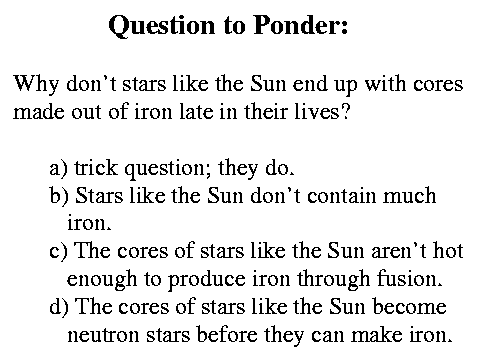|
|
here she comes again when she's dancing 'neath the starry sky she'll make you flip here she comes again when she's dancing 'neath the starry sky I kinda like the way she dips The Cars, My Best Friend's Girl |
Assignments:Read Chapter 31, Sections 3 and 4 (pp. 505-513)
Do your Observing Lab
|

In Class:
--------------
review:
Now we started this whole mess by looking at diagrams of clusters
and seeing that they all looked different
- can we explain them now? -- Of course
- the differences are all due to one parameter --- AGE
- stars of different mass evolve differently
- in particular, stars of higher mass spend less time on the MS
- if all stars are born in a cluster at the same time
(big if, by the way, but let's just go with it)
- most massive stars will move off MS first
- they use up their supplies fastest
- start their RG stages earlier
- result: MS tips more upright
- there is a "turn-off" in the MS
- where is the turnoff for a given cluster?
- at the position of the stars that have just run out of
H in their cores.
So how old is the cluster?
- however long it takes for that star to run out of H
- O stars: 10 MYR or less
- B stars: 100 MYR
- A stars: 1 BYR
- F stars: 5 BYR
- G stars: 10 BYR
- K stars: 30 BYR (longer than lifetime of the universe)
- M stars: 200 BYR
So you can date a cluster by its turnoff
- also by presence of RGs
- and WD's if the cluster is that old
- note that it takes a LONG TIME to make a WD
- WD is the end product of a LOW MASS (i.e., long-lived) star
- only the oldest clusters will have them
- Globular Clusters have them
- they must be ancient (they are)
--------------------------------------------
Milky Way
- known by anyone looking up that the distribution of stars
in the sky is _not_ uniform
- areas where there are few stars -- Cancer, Cetus
- where there are lots more stars
- Perseus, Orion, Canis Major
- in a really dark site, (or on a moonless, really clear night @Obs)
- see a band of faint light across the sky
- not hard to imagine it's the combined light of many faint
stars
- easy to see even with binoculars
- obvious in a telescope
Galileo saw in in 1610
- !Kung tribesman call it the "backbone of the sky"
- Romans term "Via Lachea" comes from Greek mythology
- milk from the breast of Hera: goddess of the skies
- progenitor of the present-day term "Milky Way"
Johann Lambert (1749) and Thomas Wright (1750)
recognized that the universe had structure
- non-isotropic distribution of stars in the night sky means
- non-isotropic distribution of stars in space
- "an ecliptic of the fixed stars"
|
![]()